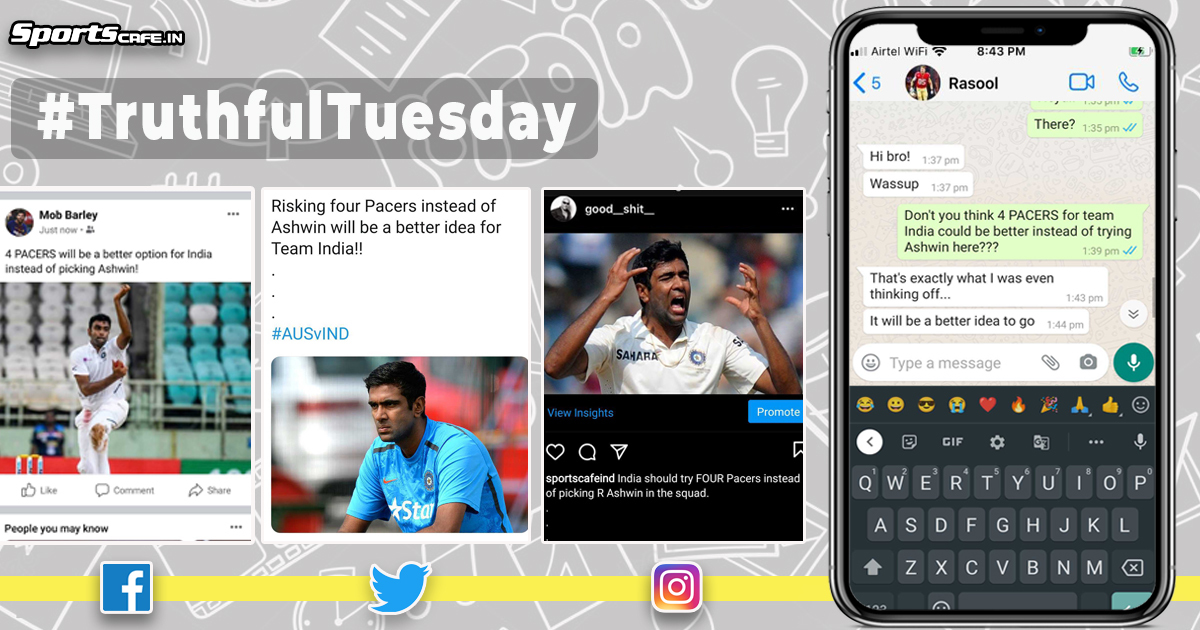Truthful Tuesday | India should risk four pacers instead of taking safe Ashwin route to go 1-0 up against Australia

India playing Ravichandran Ashwin will backfire on them
|SportsCafe
Ahead of India’s first day-night Test against Australia, in Adelaide, the popular opinion seems to suggest that Ravichandran Ashwin should be part of the playing XI purely on the basis of his performance against the Kangaroos at the venue last year. That’s where we almost get it wrong.
The safest of punts that India could take ahead of this week’s first Test in Adelaide, which incidentally is also a pink-ball clash is picking Ravichandran Ashwin in the playing XI ahead of the possibility of fielding an all-out pace attack. While that is indeed the safest of bets, it isn’t necessarily the best of ones, a recipe that has knelt the Indian side on their knees in the past and has all the ingredients of disaster while still reading ‘control.’
Now, this is where it gets tricky, what do the Indian fans really mean by taking control in Australia, a land which punishes the visitors more times than not. India’s only success in the last two decades against the Kangaroos Down Under has come on the back of a stand-out performance, even hailed as one of the best pace attacks of world cricket. The pace troika of Mohammed Shami-Jasprit Bumrah-Ishant Sharma picked up 48 wickets and that added with Umesh, makes it 50 wickets. In comparison, the spinners picked up 18 wickets.
Right there, every discussion that surrounds India’s win against Australia has the pacers with the headlining act, which essentially should prove the point in a jiffy but it’s just not that factor that rings the debate in the pacers’ favour. At the venue - the Adelaide Oval, spinners have had success but it’s only limited in comparison to the pacers who would frolic their lips looking at the surface. It is one of the best surfaces for pacers to make amends and throw the game wide open, attacking Australia where they are the weakest - at the top of the order.
What it would essentially mean is that India must go on and play one of their most daring-est setups with four frontline pacers in the form of Umesh Yadav, Mohammed Siraj, Jasprit Bumrah, and Mohammed Shami all being picked ahead of Ravichandran Ashwin and Kuldeep Yadav. Against Joe Burns and Marcus Harris, while spin has proven to be effective only in limited-measures, it was a proven fact that against quality pacers, the duo finds their willows in shreds and their confidence wailing.
Let’s address the biggest room in the elephant though - not red-ball but the pink-ball, which is going to play one of the biggest roles in the Adelaide show. Across the widths and stretch of the Australian land, spin has proven to be brittle with the pink-ball, averaging just 49 runs per wicket, inclusive of the superlative average for Australia’s very own Ashwin - Nathan Lyon, who averages 25 with the pink-cherry.
Now if you are wondering how and in which world - an average of 25 is bad, the average declines when it comes to visiting spinners with the pink-ball. There might be a few intangibles involved here - which can’t be denied including relatively alien conditions and a daunting new prospect of playing with the pink-ball. India falls under one such territory, having played just one Test under the lights.
And interestingly, in that encounter against Bangladesh, it was evident which way the pink-ball favours - the pacers picked up all the 20 wickets, spearheaded by Umesh Yadav’s rapid pace. That combined with Yadav’s brilliance against Australia in recent years, indicates every reason why they should start him and Mohammed Siraj over Ravichandran Ashwin, in what will be a sole spinner role.
Dwelling upon more facts from the previous encounters at the venue under lights, visiting spinners have managed to pick up just six wickets across seven innings, in sharp contrast to the pacers - who have walked away with as many as 43 wickets. One of the best bowlers in the format - Mitchell Starc continues to show why the pink-ball is not the best game for a spinner, with 42 wickets all at an average of 19.23 in the seven pink-ball encounters, while the Australian duo of Pat Cummins and Hazlewood picking up 19 and 26 wickets of their own, which shows the presence of the pace bowling with the pink-ball.
A short list of spinners have all tried to make their presence felt at this very venue - including Yasir Shah, Mitchell Santner, Tabraiz Shamsi, Moeen Ali, and Mark Craig but none have succeeded, which shows the blueprint to success in the cityscape of Adelaide. For India, the first Test sets up pretty much the pace of the entire series, with their skipper missing for the last three Tests and would have to utilize all the minute of chances to get one up on the opposition, and playing Ashwin would drastically handicap them.
That’s all in the past but what about now, in 2020, a year filled with extremes of unpredictability. Well ahead of the series opener, in the two warm-up games, it was pretty clear that spin wasn’t going to play a redeeming factor as both times when a team bowled an opposition out cheaply, it had pacers all over it. A ploy previously employed by India in Perth, which went against them should turn their fortune over this time around. While the execution was perfect with the ball in that Perth game, the batting was handles - miles and perhaps even country-miles away.
In particular, the pink-ball, which is essentially made with heavier lacquer to keep it well and healthy even after the early overs, steadily deteriorates in the middle-overs, with minimal or no offer for the spinners, as witnessed in the second warm-up game. India, who fielded four pacers, reaped the best rewards of going all-out attack on the first day, where they dismissed the Australian bowlers cheaply.
Now that’s a ploy and half, which the Indian bowlers in all fairness, have perfected their execution. They have done the hard yards, with their planning for the first Test now it’s the selection and the execution which could potentially hurt India from going 1-0 up and a large chunk of it depends on the management picking or not picking Ravichandran Ashwin.
Follow us on Facebook here
Stay connected with us on Twitter here
Like and share our Instagram page here
